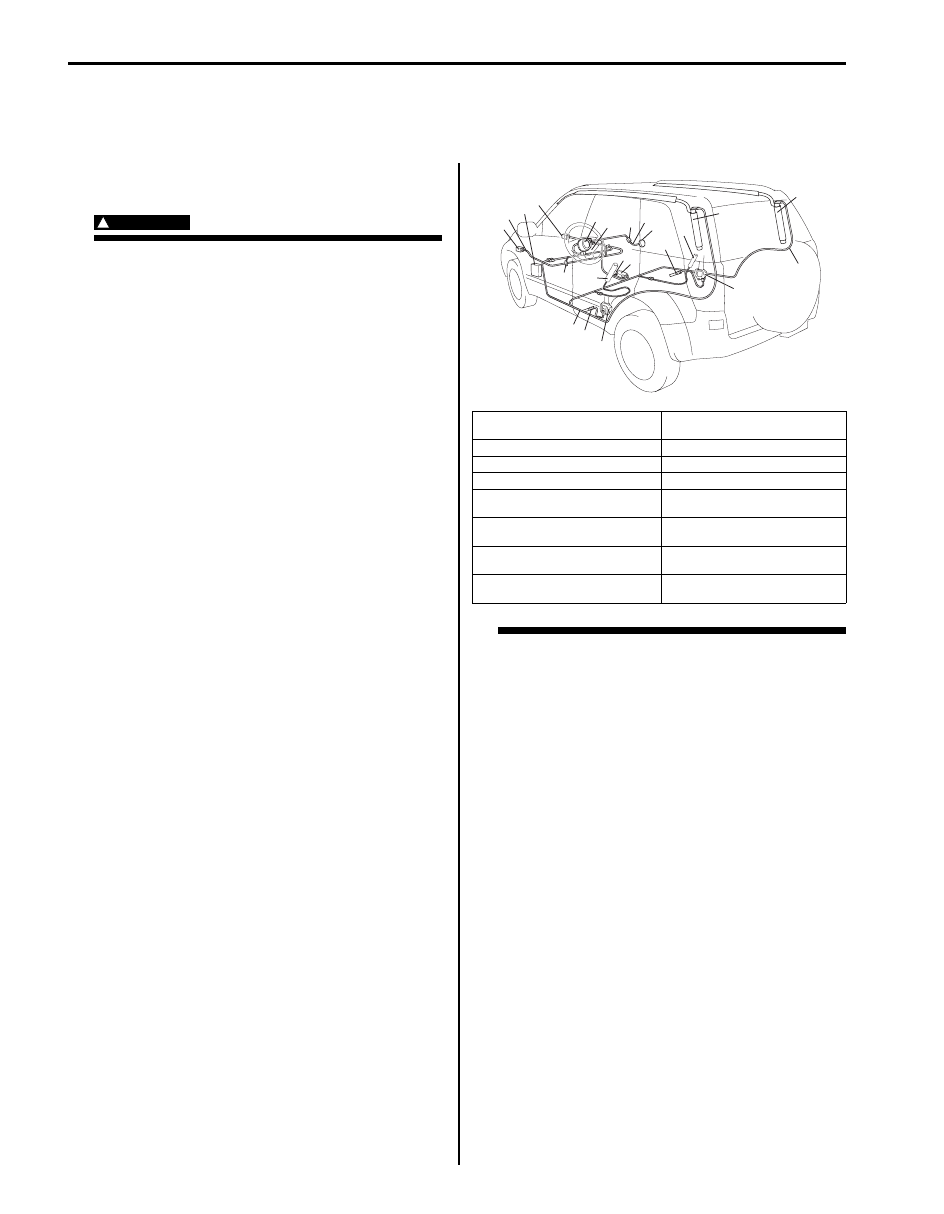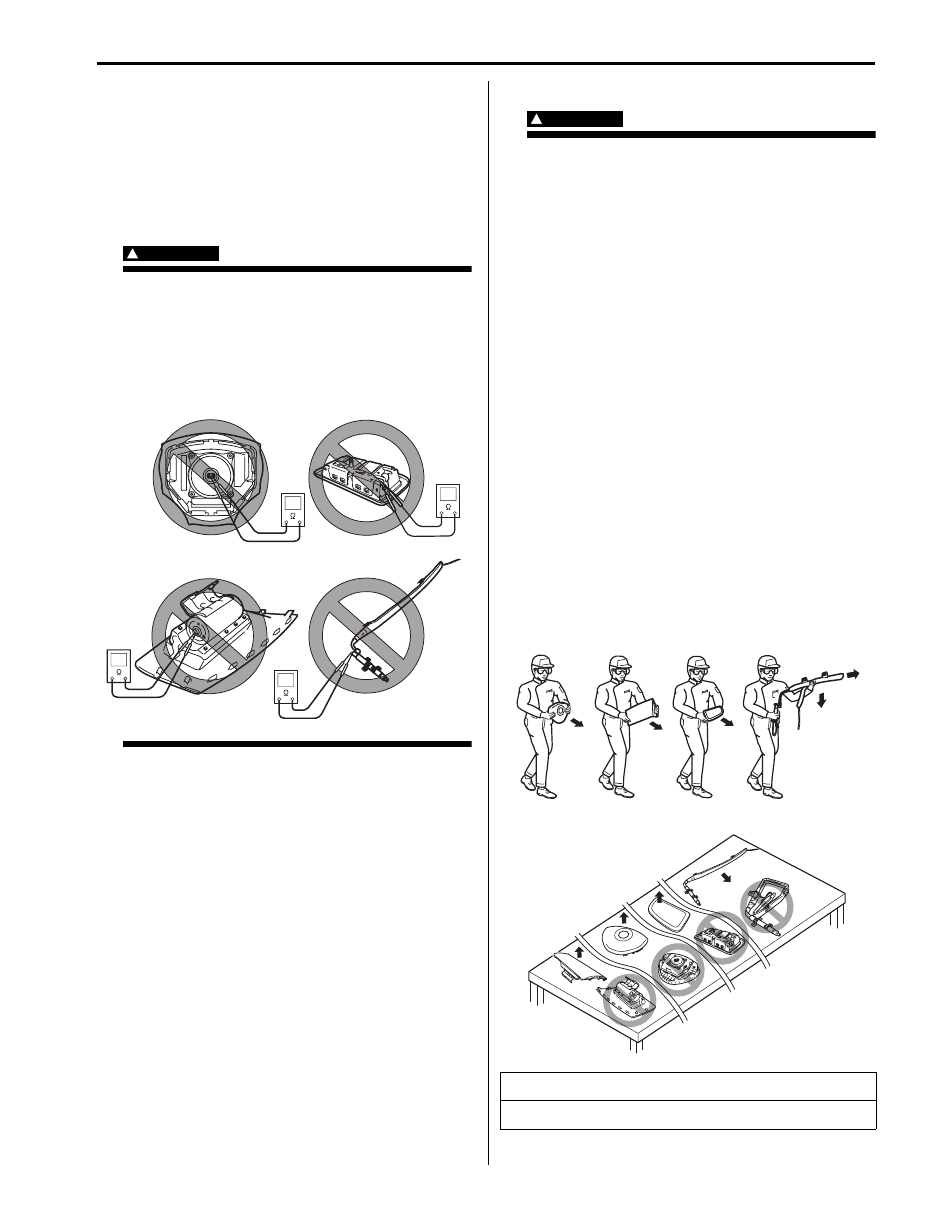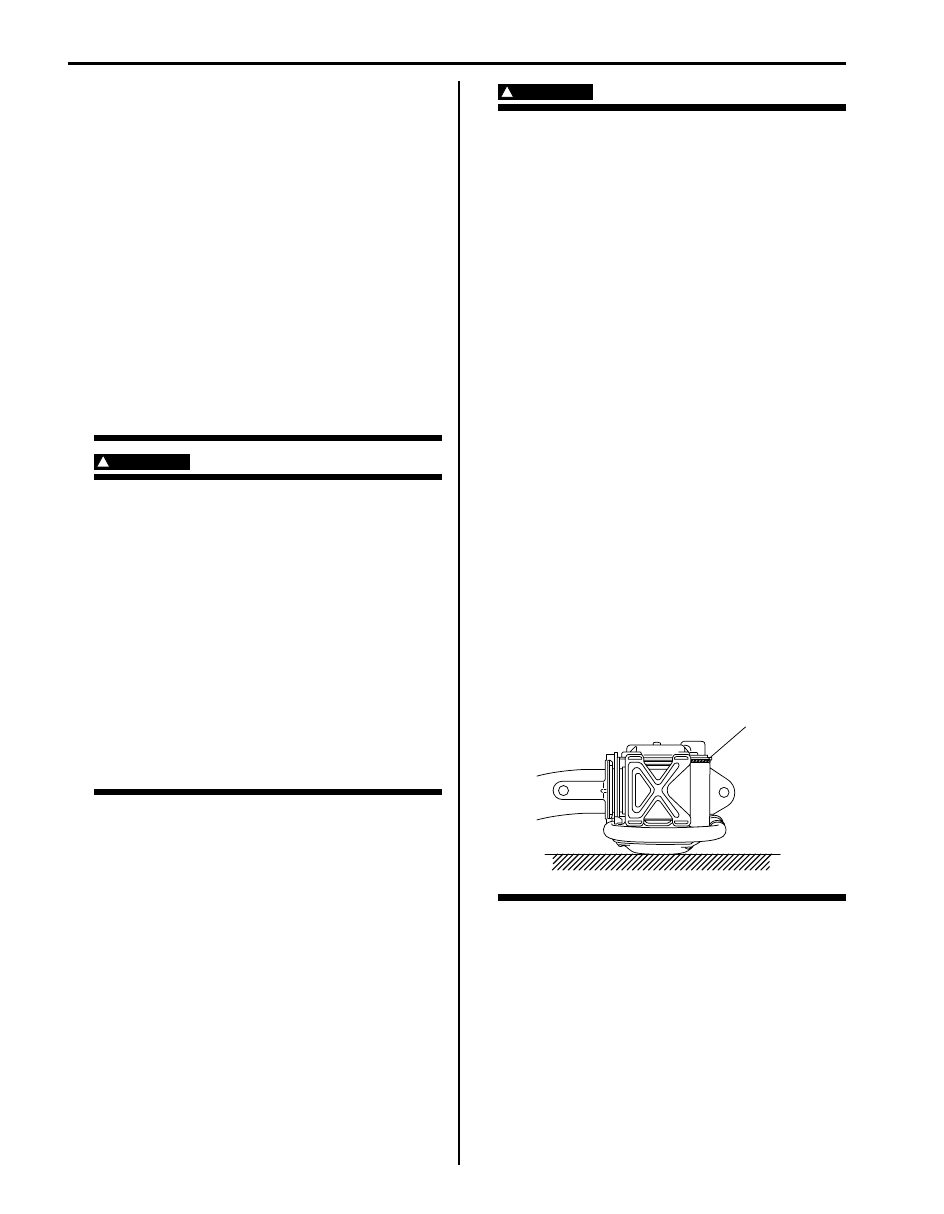Suzuki Grand Vitara JB627. Manual — part 1

00-1 Precautions:
Precautions
Precautions
Precautions
Precautions for Vehicles Equipped with a
Supplemental Restraint (Air Bag) System
S6JB0B0000001
WARNING
!
• The configuration of air bag system parts
are as shown in the figure. When it is
necessary to service (remove, reinstall and
inspect) these parts, be sure to follow
procedures described in “Precautions on
Service and Diagnosis of Air Bag System
in Section 8B”. Failure to follow proper
procedures could result in possible air bag
system activation, personal injury, damage
to parts or air bag system being unable to
activate when necessary.
• If the air bag system and another vehicle
system both need repair, SUZUKI
recommends that the air bag system be
repaired first, to help avoid unintended air
bag system activation.
• Do not modify the steering wheel,
dashboard, or any other air bag system
components.
Modifications can adversely affect air bag
system performance and lead to injury.
• If the vehicle will be exposed to
temperatures over 93
°C (200 °F) (for
example, during a paint baking process),
remove the air bag system components
beforehand to avoid component damage
or unintended air bag system activation.
1. Passenger air bag (inflator)
module
9. Ground for air bag system
2. Driver air bag (inflator) module
10. SDM
3. Contact coil assembly
11. Side-sensor (if equipped)
4. Air bag harness in main harness
12. Seat belt pretensioner
5. Forward-sensor
13. Side curtain-air bag (inflator)
module (if equipped)
6. “A/B” fuse in junction block
assembly
14. Air bag harness in instrument
panel harness
7. Air bag harness in floor harness
15. “AIR BAG” monitor coupler (if
equipped)
8. Side-air bag (inflator) module (if
equipped)
16. Passenger air bag harness
5
4
6
5
15
3
2
14
16
1
8
910
11
8
13
7
11
12
12
7
13
I5JB0A000003-02

Precautions: 00-2
Diagnosis
• When troubleshooting air bag system, be sure to
follow “Air Bag Diagnostic System Check in Section
8B”. Bypassing these procedures may result in
extended diagnostic time, incorrect diagnosis, and
incorrect parts replacement.
• Never use electrical test equipment other than that
specified.
WARNING
!
Never attempt to measure the resistance of
the air bag (inflator) modules (driver,
passenger, side and curtain) and seat belt
pretensioners (driver and passenger). It is
very dangerous as the electric current from
the tester may deploy the air bag or activate
the pretensioners.
Servicing and Handling
WARNING
!
Many of service procedures require
disconnection of “A/B” fuse and all air bag
(inflator) module(s) from system circuit to
avoid an accidental deployment.
Driver, Passenger, Side and Curtain Air Bag
(Inflator) Modules
• For handling and storage of a live air bag
(inflator) module, select a place where the
ambient temperature below 65
°C (150 °F),
without high humidity and away from
electric noise.
• When carrying a live air bag (inflator)
module, make sure the bag opening is
pointed away from you. In case of an
accidental deployment, the bag will then
deploy with minimal chance of injury.
Never carry the air bag (inflator) module by
the wires or connector on the underside of
the module. When placing a live air bag
(inflator) module on a bench or other
surface, always face the bag up, away from
the surface. This is necessary so that a
free space is provided to allow the air bag
to expand in the unlikely event of
accidental deployment. Otherwise,
personal injury may result.
I5JB0A000001-02
[A]: Always carry air bag (inflator) module with trim cover (air bag opening)
away from body.
[B]: Always place air bag (inflator) module on workbench with trim cover (air
bag opening) up, away from loose objects.
[A]
[B]
I5JB0A000002-02

00-3 Precautions:
• Never dispose of live (undeployed) air bag
(inflator) modules (driver, passenger, side
and curtain). If disposal is necessary, be
sure to deploy them according to
deployment procedures described in “Air
Bag (Inflator) Module and Seat Belt
Pretensioner Disposal in Section 8B”.
• The air bag (inflator) module immediately
after deployment is very hot. Wait for at
least half an hour to cool it off before
proceeding the work.
• After an air bag (inflator) module has been
deployed, the surface of the air bag may
contain a powdery residue. This powder
consists primarily of cornstarch (used to
lubricate the bag as it inflates) and by-
products of the chemical reaction. As with
many service procedures, gloves and
safety glasses should be worn.
WARNING
!
SDM
• During service procedures, be very careful
when handling a Sensing and Diagnostic
Module (SDM).
• Never strike or jar the SDM.
• Never power up the air bag system when
the SDM is not rigidly attached to the
vehicle. All SDM and mounting bracket
fasteners must be carefully torqued and
the arrow must be pointing toward the
front of the vehicle to ensure proper
operation of the air bag system.
The SDM could be activated when powered
while not rigidly attached to the vehicle
which could cause deployment and result
in personal injury.
WARNING
!
Driver and Passenger Seat Belt
Pretensioners
• For handling and storage of a live seat belt
pretensioner, select a place where the
ambient temperature below 65
°C (150 °F),
without high humidity and away from
electric noise.
• Never carry seat belt pretensioner by wire
or connector of pretensioner. When
placing a live seat belt pretensioner on the
workbench or some place like that, be sure
not to lay it with its exhaust hole (1)
provided side facing down. It is also
prohibited to put something on its face
with an exhaust hole or to put a seat belt
pretensioner on top of another. Otherwise,
personal injury may result.
• Never dispose of live (inactivated) seat belt
pretensioners (drive and passenger). If
disposal is necessary, be sure to activate
them according to activation procedures
described in “Air Bag (Inflator) Module and
Seat Belt Pretensioner Disposal in Section
8B” before disposal.
• The seat belt pretensioner immediately
after activation is very hot. Wait for at least
half an hour to cool it off before
proceeding the work.
• With many service procedures, gloves and
safety glasses should be worn to prevent
any possible irritation of the skin or eyes.
1
I4JA01822118-01

Precautions: 00-4
CAUTION
!
• Even when the accident was light enough
not to cause air bags to activate, be sure to
inspect system parts and other related
parts according to instructions under
“Repair and Inspection Required after
Accident in Section 8B”.
• When servicing parts other than air bag
system, if shocks may be applied to air bag
system component parts, remove those
parts beforehand.
• When handling the air bag (inflator)
modules (driver, passenger, side and
curtain), forward sensors, side sensors or
SDM, be careful not to drop it or apply an
impact to it. If an excessive impact was
applied (e.g., dropped from a height of 91.4
cm (3 feet) or more), never attempt
disassembly or repair but replace it with a
new one.
• When grease, cleaning agent, oil, water,
etc. has got onto air bag (inflator) modules
(driver, passenger, side and curtain), wipe
off immediately with a dry cloth.
• Air bag wire harness is included in main
harness, instrument panel harness, floor
harness and seat harness. Air bag wire
harness can be identified easily as the part
of connector side wire harness is covered
with a yellow protection tube and it has
yellow connectors. Be very careful when
handling it.
• When an open in air bag wire harness,
damaged wire harness, connector or
terminal is found, replace wire harness,
connectors and terminals as an assembly.
• Do not apply power to the air bag system
unless all components are connected or a
diagnostic flow requests it, as this will set
a DTC.
• Never use air bag system component parts
from another vehicle.
• When using electric welding, be sure to
temporarily disable air bag system
referring to “Disabling Air Bag System in
Section 8B”.
• Never expose air bag system component
parts directly to hot air (drying or baking
the vehicle after painting) or flames.
• WARNING / CAUTION labels are attached
on each part of air bag system
components. Be sure to follow the
instructions.
• After vehicle is completely repaired,
perform “Air Bag Diagnostic System
Check in Section 8B”.
General Precautions
S6JB0B0000002
The WARNING and CAUTION describe some general
precautions that you should observe when servicing a
vehicle. These general precautions apply to many of the
service procedures, and they will not necessarily be
repeated with each procedure to which they apply.
WARNING
!
• Whenever raising a vehicle for service, be
sure to follow the instructions under
“Vehicle Lifting Points in Section 0A”.
• When it is necessary to do service work
with the engine running, make sure that
the parking brake is set fully and the
transmission is in Neutral (for manual
transmission vehicles) or Park (for
automatic transmission vehicles), Keep
hands, hair, clothing, tools, etc. away from
the fan and belts when the engine is
running.
• When it is necessary to run the engine
indoors, make sure that the exhaust gas is
forced outdoors.
• Do not perform service work in areas
where combustible materials can come in
contact with a hot exhaust system. When
working with toxic or flammable materials
(such as gasoline and refrigerant), make
sure that the area you work in is well-
ventilated.
• To avoid getting burned, keep away from
hot metal parts such as the radiator,
exhaust manifold, tail pipe, muffler, etc.
• New and used engine oil can be
hazardous. Children and pets may be
harmed by swallowing new or used oil.
Keep new and used oil and used engine oil
filters away from children and pets.
Continuous contact with used engine oil
has been found to cause [skin] cancer in
laboratory animals. Brief contact with used
oil may irritate skin. To minimize your
exposure to used engine oil, wear a long-
sleeve shirt and moisture-proof gloves
(such as dish washing gloves) when
changing engine oil. If engine oil contacts
your skin, wash thoroughly with soap and
water. Launder any clothing or rags if wet
with oil, recycle or properly dispose of
used oil and filters.

Нет комментариевНе стесняйтесь поделиться с нами вашим ценным мнением.
Текст